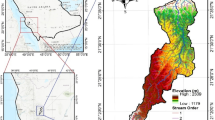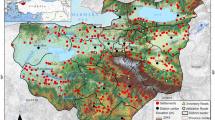Abstract
Different tools and models are nowadays available for the identification of flood-prone areas. The application of these approaches is strongly influenced by the availability of site-specific hydrological information. As an example, a combined scheme of hydrological and hydraulic models for the definition of flood events is reliable when there are lots of hydrological and hydraulic information, which makes it difficult to be exploited in ungauged catchment. In this context, DTM-based geomorphological methods are able to provide a rapid identification of a flood susceptibility where the availability of data directly observed in situ is limited. In this study we investigated ability and performances of two morphological descriptors in defining flood exposure with respect to accuracy of morphological information in the context of ephemeral streams located in Puglia region (Southern Italy). Results showed an influence of data resolution on descriptors performances, providing an additional contribution to the investigations carried out in similar areas during last years.
Access this chapter
Tax calculation will be finalised at checkout
Purchases are for personal use only
Similar content being viewed by others
References
Iacobellis, V., et al.: Investigation of a Flood Event Occurred on Lama Balice, in the Context of Hazard Map Evaluation in Karstic-Ephemeral Streams. In: Gervasi, O., et al. (eds.) ICCSA 2018. LNCS, vol. 10964, pp. 317–333. Springer, Cham (2018). https://doi.org/10.1007/978-3-319-95174-4_26
Morita, M., Yamaguchi, H.: Quantification of increased flood risk caused by global climate change for urban river management planning. In: 7th NOVATECH, Conference on Sustainable Techniques and Strategies for Urban Water Management, Lyon, France (2010)
Kazama, S., Sato, A., Kawagoe, S.: Evaluating the cost of flood damage based on changes in extreme rainfall in Japan. Sustain. Sci. 4(1), 61–69 (2009)
Zhou, Q., Mikkelsen, P.S., Halsnæs, K., Arnbjerg-Nielsen, K.: Framework for economic pluvial flood risk assessment considering climate change effects and adaptation benefits. J. Hydrol. 414–415, 539–549 (2012)
Kundzewicz, Z.W., et al.: Flood risk and climate change: global and regional perspectives. Hydrol. Sci. J. 59(1), 1–28 (2014). https://doi.org/10.1080/02626667.2013.857411
Sangiorgio, V., Fiorito, F., Santamouris, M.: Development of a holistic urban heat island evaluation methodology. Sci. Rep. 10(1), 1–13 (2020). https://doi.org/10.1038/s41598-020-75018-4
Sangiorgio, V., Uva, G., Adam, J.M.: Integrated seismic vulnerability assessment of historical masonry churches including architectural and artistic assets based on macro-element approach. Int. J. Arch. Heritage (2020). https://doi.org/10.1080/15583058.2019.1709916
Fidelibus, M.D., Balacco, G., Gioia, A., Iacobellis, V., Spilotro, G.: Mass transport triggered by heavy rainfall: the role of endorheic basins and epikarst in a regional karst aquifer. Hydrol. Process. (2017). https://doi.org/10.1002/hyp.11037
Balacco, G.: The interrill erosion for a sandy loam soil. Int. J. Sediment Res. (2013). https://doi.org/10.1016/S1001-6279(13)60043-8
Montanari, A., et al.: “Panta Rhei—everything flows”: change in hydrology and society—the IAHS Scientific Decade 2013–2022. Hydrol. Sci. J. 58(6), 1256–1275 (2013). https://doi.org/10.1080/02626667.2013.809088
Morse, C.C., Huryn, A.D., Cronan, C.: Impervious surface areas as a predictor of the effects of urbanization on stream insect communities in Maine, USA. Environ. Monit. Assess. 89, 95–127 (2003)
Carlson, T.N., Arthur, S.T.: The impact of land use — land cover changes due to urbanization on surface microclimate and hydrology: a satellite perspective. Global Planet. Change 25(1), 49–65 (2000)
Mattia, F., et al.: Time series of COSMO-SkyMed data for landcover classification and surface parameter retrieval over agricultural sites. In: Proceedings of the IEEE 2012 International Geoscience and Remote Sensing Symposium, IGARSS 2012, Munich, Germany, 22–27 July, 2012, IEEE Publications (USA, 2012), pp. 6511–6514, ISBN:978-1-4673-1159-5.
Jain, S.K., Singh, R.D., Jain, M.K., Lohani, A.K.: Delineation of flood-prone areas using remote sensing techniques. Water Resour. Manage. 19, 333 (2005). https://doi.org/10.1007/s11269-005-3281-5
De Giorgis, M., Gnecco, G., Gorni, S., Roth, G., Sanguineti, M., Taramasso, A.C.: Classifiers for the detection of flood-prone areas using remote sensed elevation data. J. Hydrol. 470–471, 302–315 (2012)
Manfreda, S., et al.: Flood-prone areas assessment using linear binary classifiers based on flood maps obtained from 1D and 2D hydraulic models. Nat. Hazards 79(2), 735–754 (2015). https://doi.org/10.1007/s11069-015-1869-5
Balenzano, A., et al.: A ground network for sar-derived soil moisture product calibration, validation and exploitation in southern Italy. In: Proceedings of the IEEE 2014 International Geoscience and Remote Sensing Symposium, IGARSS 2014, Quèbec, Canada July 13–18 (2014)
Beven, K.: Rainfall-Runoff Modelling The Primer, 2nd edn. Wiley-Blackwell, Chichester, UK (2012)
Gioia, A., Manfreda, S., Iacobellis, V., Fiorentino, M.: Performance of a theoretical model for the description of water balance and runoff dynamics in Southern Italy. J. Hydrol. Eng. 19(6), 1113–1123 (2014). https://doi.org/10.1061/(ASCE)HE.1943-5584.0000879
Gioia, A.: Reservoir routing on double-peak design flood. Water 8, 553 (2016)
Johnston, P.R., Pilgrim, D.H.: Parameter optimization for watershed models. Water Resour. Res. 12(3), 477–486 (1976)
Williams, B.J., Yeh, W.W.G.: Parameter estimation in rainfall-runoff models. J. Hydrol. 63, 373–393 (1983)
Jiang, Y., Liu, C., Li, X., Liu, L., Wang, H.: Rainfall-runoff modeling, parameter estimation and sensitivity analysis in a semiarid catchment. Environ. Model. Softw. 67, 72–88 (2015)
Grimaldi, S., Nardi, F., Piscopia, R., Petroselli, A., Apollonio, C.: Continuous hydrologic modelling for design simulation in small and ungauged basins: a step forward and some tests for its practical use. J. Hydrol. 595, 125664 (2021). ISSN 0022-1694, https://doi.org/10.1016/j.jhydrol.2020.125664.
Annis, A., et al.: UAV-DEMs for small-scale flood hazard mapping. Water 12, 1717 (2020). https://doi.org/10.3390/w12061717
Manfreda, S., Di Leo, M., Sole, A.: Detection of flood prone areas using digital elevation models. J. Hydrol. Eng. 16(10), 781–790 (2011). https://doi.org/10.1061/(ASCE)HE.1943-5584.0000367
Samela, C., Manfreda, S., Paola, F.D., Giugni, M., Sole, A., Fiorentino, M.: DEM-based approaches for the delineation of flood-prone areas in an ungauged basin in Africa. J. Hydrol. Eng. (2015). https://doi.org/10.1061/(ASCE)HE.1943-5584
Samela, C., Troy, T.J., Manfreda, S.: Flood hazard mapping over large regions. Adv. Water Resour. (2017)
Slatton, K.C., Carter, W.E., Shrestha, R.L., Dietrich, W.E.: Airborne laser swath mapping: achieving the resolution and accuracy required for geosurficial research. Geophys. Res. Lett. 34, L23S10 (2007). https://doi.org/10.1029/2007GL031939
Dodov, B.A., Foufoula-Georgiou, E.: Floodplain morphometry extraction from a high-resolution digital elevation model: a simple algorithm for regional analysis studies. Geosci. Remote Sens. Lett. IEEE 3(3), 410–413 (2006). https://doi.org/10.1109/LGRS.2006.874161
De Risi, R., Jalayer, F., De Paola, F., Giugni, M.: Probabilistic delineation of flood-prone areas based on a digital elevation model and the extent of historical flooding: the case of Ouagadougou. Boletín Geol. Minero 125, 329–340 (2014)
Nardi, F., Vivoni, E.R., Grimaldi, S.: Investigating a floodplain scaling relation using a hydrogeomorphic delineation method. Water Resour. Res. 42(9), W09409 (2006)
Gioia, A., Totaro, V., Bonelli, R., Esposito, A.A.M.G., Balacco, G., Iacobellis, V.: Flood susceptibility evaluation on ephemeral streams of southern Italy: a case study of Lama Balice. In: Gervasi, O., et al. (eds.) ICCSA 2018. LNCS, vol. 10964, pp. 334–348. Springer, Cham (2018). https://doi.org/10.1007/978-3-319-95174-4_27
Natural Park of Lama Balice: https://www.parcolamabalice.it/. Accessed 5 May 2021
Mossa, M.: The floods in Bari: what history should have taught. J. Hydraul. Res. 45(5), 579–594 (2007). https://doi.org/10.1080/00221686.2007.9521795
Balacco, G., Totaro, V., Gioia, A., Piccinni, A.F.: Evaluation of geomorphic descriptors thresholds for flood prone areas detection on ephemeral streams in the metropolitan area of Bari (Italy). In: Misra, S., et al. (eds.) ICCSA 2019. LNCS, vol. 11622, pp. 239–254. Springer, Cham (2019). https://doi.org/10.1007/978-3-030-24305-0_19
Samela, C., Manfreda, S., Paola, F.D., Giugni, M., Sole, A., Fiorentino, M.: DEM-based approaches for the delineation of flood-prone areas in an ungauged basin in Africa. J. Hydrol. Eng. (2015). https://doi.org/10.1061/(ASCE)HE.1943-5584.0001272
Author information
Authors and Affiliations
Corresponding author
Editor information
Editors and Affiliations
Rights and permissions
Copyright information
© 2021 Springer Nature Switzerland AG
About this paper
Cite this paper
Carbone, F., Balacco, G., Totaro, V., Gioia, A. (2021). Notes on the Performances of Morphological Descriptors for the Evaluation of Flood Susceptibility in Apulian Ephemeral Streams. In: Gervasi, O., et al. Computational Science and Its Applications – ICCSA 2021. ICCSA 2021. Lecture Notes in Computer Science(), vol 12955. Springer, Cham. https://doi.org/10.1007/978-3-030-87007-2_6
Download citation
DOI: https://doi.org/10.1007/978-3-030-87007-2_6
Published:
Publisher Name: Springer, Cham
Print ISBN: 978-3-030-87006-5
Online ISBN: 978-3-030-87007-2
eBook Packages: Computer ScienceComputer Science (R0)




